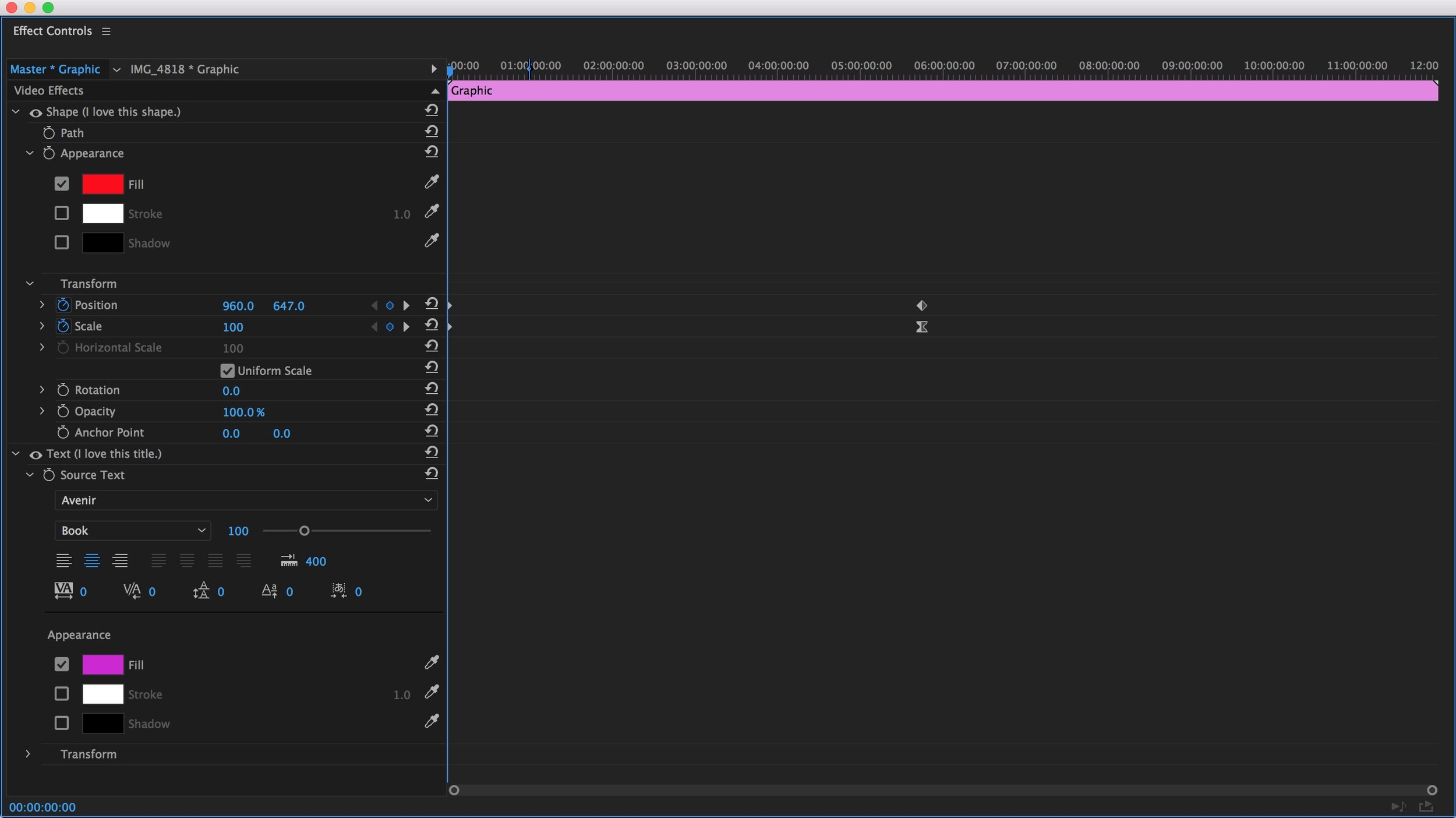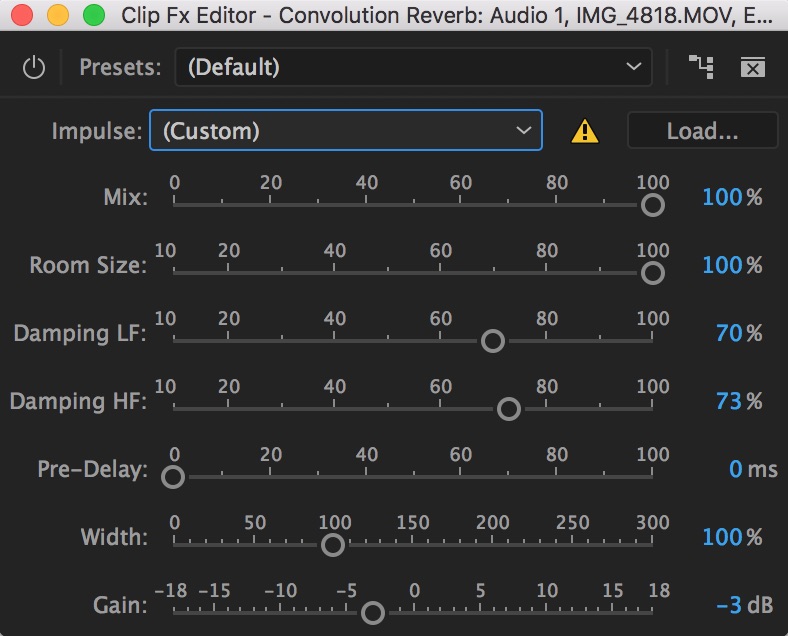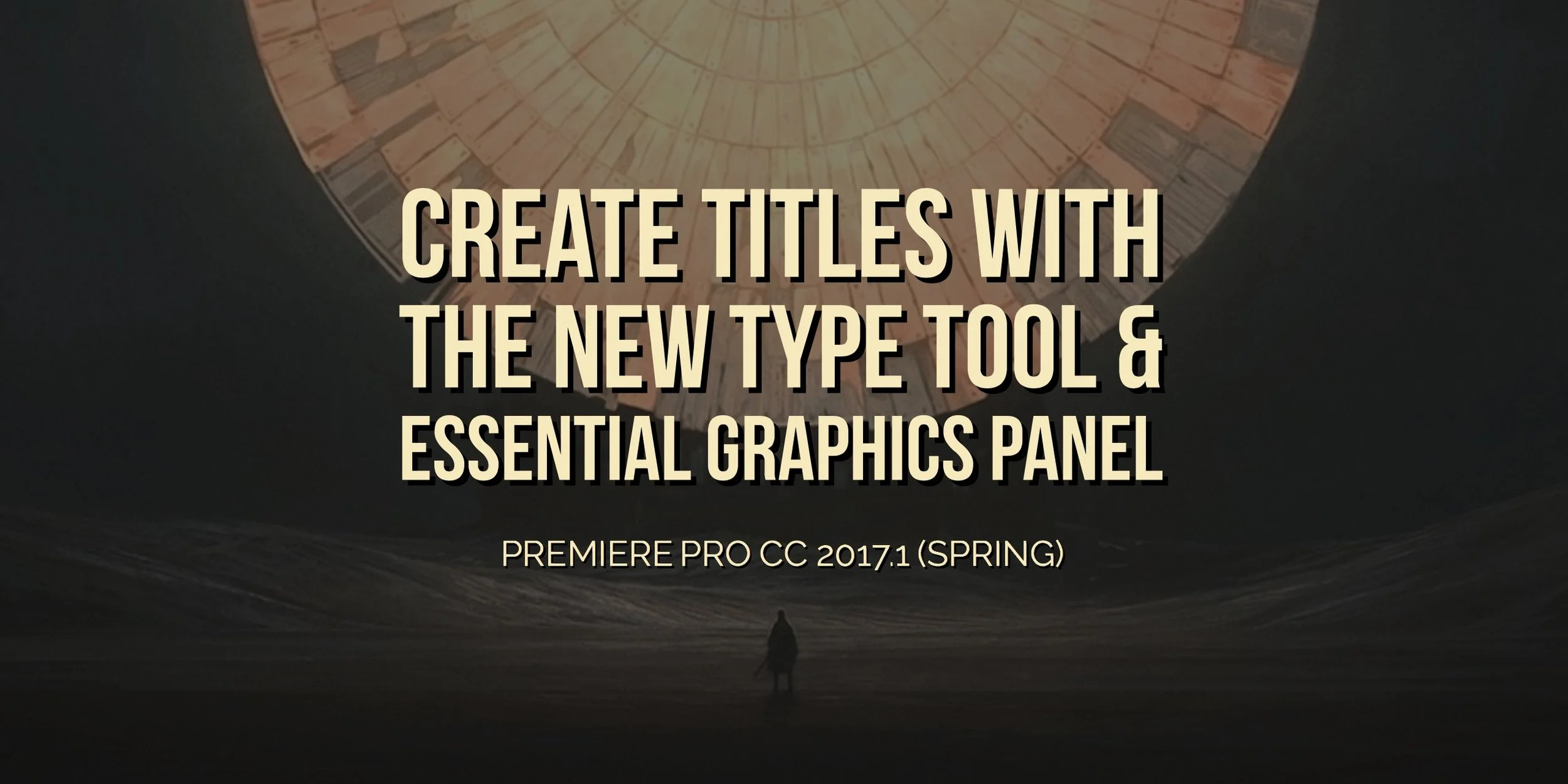Premiere Pro CC 2017.1 (Spring): Creativity Made Simple, Not Simplistic
Essential Graphics Panel, Essential Sound Panel, Type Tool, Motion Graphics Templates, and More in Premiere Pro CC 2017.1 (Spring)
It's no exaggeration to say that Premiere Pro CC 2017.1 completely reinvents text, motion graphics, and audio workflows in Premiere Pro CC. And the best part is all these features are available to Creative Cloud customers today!
The latest release of Premiere Pro CC offers powerful new workflows for graphics, titles, and audio, as well as a new level of integration with After Effects and Audition.
WARNING: Unlike previous releases, Premiere Pro CC 2017.1 will overwrite the CC 2017 version with NO option to Keep Previous Versions. Existing Premiere Pro project files need to be updated to be compatible with Premiere Pro CC 2017.1. Here's how to install previous versions of Creative Cloud applications. Update at your own risk.
The new Essential Graphics and Essential Sound panels in the Premiere Pro CC 2017.1 (Spring) release simplify creative workflows for video creators without making them simplistic in any way. These new tools demonstrate Adobe's clear understanding that professional and amateur video creators alike are producing content faster and with higher fidelity than ever before. Adobe is supporting the demands of accelerating creative workflows with continued integration between the Creative Cloud video and audio applications. The new Motion Graphics Templates from After Effects CC and enhanced interchange with Audition CC further condenses the postproduction pipeline, and makes it easier for editors to remain focused on their work in Premiere Pro CC.
Essential Graphics Panel
Feature requests for an improved text and graphics workflow in Premiere Pro are answered in CC 2017.1. Meet the all-new Essential Graphics panel in Premiere Pro. It's one sexy beast. Similar to the Lumetri Color panel and the new Essential Sound panel (spoiler), the Essential Graphics panel is now the primary place for designing and editing text and graphics in Premiere Pro CC.
Experience a modern, intuitive way to create titles and motion graphics in the Essential Graphics panel, new to Premiere Pro CC in the April 2017 release of Adobe Creative Cloud.
The old Title Designer was certainly powerful, but it felt clunky and joyless. The Essential Graphics panel in Premiere Pro CC 2017.1 restores the thrill of designing titles and graphics, especially for editors. Editing titles and graphics in the Essential Graphics panel feels intuitive and fresh, even though you will recognize many of the type tools common to other Adobe applications.
Tutorial: Create Title with the New Type Tool and Essential Graphics Panel in Premiere Pro CC 2017.1
Type Tool
Creating a title in Premiere Pro CC 2017.1 is now as simple as typing in the Program monitor. The new Type tool is part of the main interface next to all the other editing tools.
Create a Text layer using the new Type tool available now in the April 2017 release of Premiere Pro CC. Place titles and graphics directly on the Program monitor or click and drag to create a text area.
No, you're not crazy - the option to create a New Title has been removed from Premiere Pro CC 2017.1. Instead, select the Type tool and create the text directly in the Program monitor.
(Note: You can still create Titles the old way under File > New > Legacy Title.)
Motion Graphics Templates
The 2017 Spring update introduces Motion Graphics Templates, a streamlined motion graphics solution for After Effects CC and Premiere Pro CC. Motion Graphics Templates is the culmination of Live Text Templates, and they replace the option to export Composition as Text Template in After Effects. There's no more ambiguity editable text in Dynamically Linked comps Inside Premiere Pro, it's all Motion Graphics Templates now.
Find all the controls you need to create and edit templates in the April 2017 release of Premiere Pro CC. Apply titles, shapes, and other items in the Essential Graphics panel and save as a Motion Graphics template to use over and over again.
The Essential Graphics panel also lives in After Effects CC but has a completely different functionality than in Premiere Pro CC. Design complex motion graphics in After Effects CC and decide which parameters the editor can modify simply by dragging specific properties to the Essential Graphics panel.
With the April 2017 release of Adobe Creative Cloud, quickly access frequently-changed properties and retain stylistic control of your compositions by packaging them up as a Motion Graphics template in the Essential Graphics panel and sharing them with Premiere Pro editors.
Back in Premiere Pro CC, all the properties added to the Motion Graphics Template in After Effects CC can be adjusted by the editor. In the screenshots below you can see the Blur Radius is included in the Essential Graphics panel so the editor can customize the amount of blur in Premiere Pro CC. Additionally, you can create your own Motion Graphics Templates in Premiere Pro CC and save them locally or share them with collaborators via Creative Cloud Libraries.
Last thing about Motion Graphics Templates: both Premiere Pro CC and After Effects CC each come with their own preset templates for lower thirds, social media, credits, and more. Motion Graphics Templates DO NOT require After Effects CC to be installed in order to work in Premiere Pro CC.
TUTORIAL: MOTION GRAPHICS TEMPLATE WORKFLOW IN AFTER EFFECTS AND PREMIERE PRO CC 2017 (SPRING)
Essential Sound Panel
We all saw (or heard) this one coming when the Essential Sound panel was introduced in Audition. It makes total sense that it should be brought over to Premiere Pro CC. Well, now it is, and it dramatically simplifies audio workflows for editors in Premiere Pro CC.
With the April 2017 release of Adobe Creative Cloud, the Essential Sound panel is now available in Premiere Pro and Audition CC. It provides an intuitive, powerful audio editing experience focused on creative intent, without requiring audio engineering expertise.
The Essential Sound panel is the ideal solution for editors who want to make basic improvements to their audio before auditioning their work to a client or director. If you're not familiar with the Essential Sound panel from Audition, think of it like a friendly UI for many of the existing Adobe audio effects.
Making an adjustment in the Essential Sound panel in Premiere Pro CC automatically applies the corresponding audio effects to the clips selected in your Timeline. You can animate and further refine your audio adjustments in the Effect Controls panel. The power of the Essential Sound panel is a single slider can control multiple audio effects applied to your clips. And the best part is all of the adjustments made in the Essential Sound panel in Premiere Pro can be handed off to a professional sound engineer working in Adobe Audition.
Enhanced Interchange Premiere Pro and Audition
Adobe claims the latest updates to the interchange between Premiere Pro CC and Audition CC "preserves more timeline information than any NLE to DAW interchange solution available." Audio keyframes made in Premiere Pro CC can be sent over to Audition CC where they can be finetuned. This goes for all of Adobe's audio effects, and also any third party VST or Audio Unit plugins as well.
With the April 2017 release of Adobe Creative Cloud, the workflow between Premiere Pro and Audition, along with new audio effects in Premiere, enables the most efficient interchange experience in the industry, with lossless transfer and no intermediate rendering.
Sequences with complex audio routing using adaptive or submix tracks are also preserved when sent to Audition CC. And that's not all. Clip colors, labels, track arrangement are also conveniently carried over to Audition CC. All of these enhancements to the Premiere Pro CC and Audition CC interchange make it easier for a professional sound engineer to understand the editor's creative "vision" for the audio.
Audio Effect Enhancements
The CC 2017.1 release introduces real-time frequency spectral meters, level meters, and gain adjustment meters within the audio effects themselves in both Premiere Pro CC and Audition CC.
New and updated audio effects available now in the April 2017 release of Audition and Premiere Pro CC provide parity across both apps, making it easy for users to move between the two. Many existing audio effects now have spectral meters, gain meters, and gain reduction meters for improved visibility into audio adjustments.
For example, when you apply a Parametric EQ to your audio clips in Premiere Pro CC, you will be able to visually identify unwanted frequencies in the graph during playback. Likewise, the Dynamics Processing effect shows the input level in the graph, and a gain reduction meter on the right shows the results of threshold and loudness adjustments - all in real-time.
New Convolution Reverb and DeEsser Audio Effects
CC 2017.1 also features a brand new Convolution Reverb effect. Apply this effect to match the ambience of clips recorded in different environments. Choose from preset Impulses or load your own. There is also a new DeEsser which some users will recognize from Audition.
Adobe Stock Destination Publishing
Have some unused b-roll clips in your project? Premiere Pro CC 2017.1 adds destination publishing directly to Adobe Stock. So your project can literally start earning revenue while you're editing.
With the April 2017 updates to Adobe Creative Cloud, editors looking to monetize their work and reach millions of creative buyers can now submit video content directly to Adobe Stock via Premiere Pro or Adobe Media Encoder.
Adobe has made it beautifully simple to export your footage to Adobe Stock. Sign up to be an Adobe Stock contributor, login into your account in the Publish tab of the Export Settings window, and Adobe Media Encoder does the rest. No need to worry about codecs or bitrates. You can be confident that your stock video will look awesome thanks to the Adobe Stock encoding preset. Once the export is complete, you will need to answer some common stock video questions and add description and keywords before your video is available on the Adobe Stock marketplace.
Additionally, you can now search Adobe Stock video clips (with previews!) directly in the Libraries panel in Premiere Pro CC. Adobe has also announced their partnership with Pond5.
More New Features
- Color Workflows: Lumetri Tonal Controls are adjusted to work with overbrights
- Improved Playback Performance for XAVC 4K 60p
- In and Out Points can be used for partial ingest
- Three Axis rotation for VR Workflows
- Batch edit function for captions
- MacBook TouchBar support – with great options to customize
- Microsoft Dial support
- AME as a Windows Service
- AME auto relink of assets
- AME support for Team Projects
- Support for Dynamic Link with Team Projects
- Media cache expiration policies
- New audio effects & improved integration with Audition
- Match frame from subclip
- Hybrid Log Gamma (HLG) for HDR workflows with output to XAV
- New formats (including Avid XDCAM OP-Atom, ProRes MXF, Panasonic LT, AVC-Ultra LongG export)
Helpful Links
- Click here to read Adobe's official blog post The Latest (and Greatest!) for Premiere Pro CC and Media Encoder
- Check out Adobe Updates Premiere Pro CC for April 2017 by Scott Simmons for in-depth look at what's new in Premiere Pro CC 2017.1.
- Watch reTooled.net's video summary Premiere Pro CC – April 2017- New Features and the Essential Graphics Panel
- Watch Cinecom.net's top 5 New Features in Premiere Pro CC 2017 (April Spring Update)
- For a close look at the new features in Creatve Cloud 2017 Spring release, watch the video below by Adobe's Dave Helmly.
In this video I'll review the top features in the Spring 2017 release of Premiere Pro CC v11.1. You'll see an entirely new workflow for creating Motion Graphics Templates (Premiere and AfterEffects) and our new file format for these templates - .mogrt files.
What do you think of the new features in Premiere Pro CC 2017.1? Got any helpful tips or insights? Please share them in the comments!




























